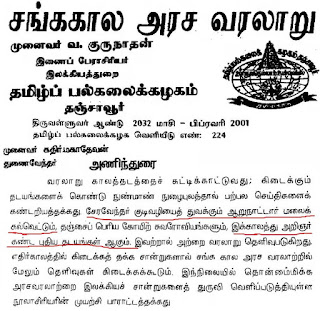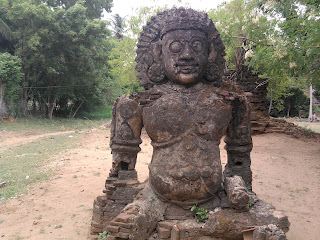தொல்காப்பியத்தின் காலக்கணிப்பு கடினமானது, அதிக விவாதத்திற்கு உட்பட்டது, மேலும் அது போட்டியாகவும் நிச்சயமற்றதாகவும் உள்ளது.[20][21] முன்மொழிவுகள் கிமு 5,320 மற்றும் கிபி 8 ஆம் நூற்றாண்டுக்கு இடைப்பட்டவை.[21][22]
பாரம்பரியம் மற்றும் சில இந்திய அறிஞர்கள், பொதுவான சகாப்தத்திற்கு முன், அதன் அமைப்புக்கான ஆரம்ப தேதியை ஆதரிக்கின்றனர், மேலும் இது அகஸ்திய முனிவருடன் தொடர்புடைய ஒருவரின் வேலை என்று குறிப்பிடுகின்றனர். மற்ற இந்திய அறிஞர்கள் மற்றும் கமில் ஸ்வெலேபில் போன்ற இந்தியர் அல்லாத அறிஞர்கள் இதை ஒரு தனி நிறுவனமாக இல்லாமல் பகுதிகள் அல்லது அடுக்குகளில் தேதியிட விரும்புகிறார்கள்.[23] தொல்காப்பியம் கையெழுத்துப் பிரதிகள் நவீன யுகம் வரை நிலைத்து நிற்கின்றன என்பது 5ஆம் நூற்றாண்டு கிபியில் ஸ்வெலேபில் படி நிறுவப்பட்டது.[20][23][24] மூன்று சங்கங்கள் மற்றும் பெரும் வெள்ளம் பற்றிய கட்டுக்கதைகளை அடிப்படையாகக் கொண்ட பாரம்பரிய காலகட்டங்களை அறிஞர்கள் நிராகரிக்கின்றனர், ஏனெனில் அதற்குச் சாதகமாக சரிபார்க்கக்கூடிய சான்றுகள் இல்லை, மேலும் மொழியியல், கல்வெட்டு, சங்க இலக்கியம் மற்றும் பிற இந்திய நூல்களின் அடிப்படையில் கிடைக்கக்கூடிய சான்றுகள் மிகவும் பிந்தைய தேதியைக் கூறுகின்றன.[25] இப்போது கருத்து வேறுபாடுகள் கிமு 3 ஆம் நூற்றாண்டுக்கும் கிபி 8 ஆம் நூற்றாண்டுக்கும் இடைப்பட்ட காலங்களை மையமாகக் கொண்டுள்ளன.[20][25][26]
சமகால அறிஞர்களால் முன்மொழியப்பட்ட தேதிகள் போன்ற சான்றுகளின் கலவையை அடிப்படையாகக் கொண்டது:
தொல்காப்பியத்தில் கற்பிக்கப்படும் இலக்கணத்தையும் பழமையான தமிழ்-பிராமி மற்றும் பழைய-தமிழ் கல்வெட்டுகளில் காணப்படும் இலக்கணத்தையும் ஒப்பிடுதல்[6][20]

தொல்காப்பியம் கால ஆய்வுக்கு முக்கிய கருது பொருட்கள்
1. தொல்காப்பியத்தில் காணும் எழுத்து இலக்கணத்தையும் பழமையான தமிழ்-பிராமி மற்றும் பழைய-தமிழ் கல்வெட்டுகளில் காணப்படும் இலக்கணத்தையும் ஒப்பிடுதல்
2. தொல்காப்பியத்தில் கூறப்படும் இலக்கணத்தை பழமையான தமிழ் பாட்டுத் தொகை நூல்களில் காணப்படும் யாப்பு அமைப்போடு ஒப்பிடுதல்; இந்தச் ஒலிப்பு வடிவ தரவுகள், உச்சரிப்பு மற்றும் சொல் மற்றும் சொற்றொடர் கூட்டுகள் பயன்பாட்டில் ஏற்பட்ட தொடர் வளர்ச்சி போன்றவற்றை உள்ளடக்கியது
3. தொல்காப்பியத்தில்
கூறப்படும் இலக்கணத்தை பழமையான சமஸ்கிருத நூல்களில் கூறப்படும் மற்றும் அமைந்துள்ள இலக்கணத்தோடு ஒப்பிடுதல்
4. தொல்காப்பியத்தில் காணப்படும் வாக்கியங்கள் மற்றும் சொற்றொடர்களை சமஸ்கிருத நூல்களான பாணினி, பதஞ்சலி, மனு, கௌடில்யர், பரதர் மற்றும் வாத்ஸ்யாயனர்.ஒப்பீடு
5. தொல்காப்பியத்தில் கூறப்படும் கவிதை மற்றும் உரைநடை விதிகளை ஆரம்பகால தமிழ் கவிதை மற்றும் உரைநடையோடு ஒப்பீடு செய்தல்
6. பிராகிருதம் மற்றும் சமஸ்கிருத கடன் வார்த்தைகள் (வடசொல்); இத்தோடு தொல்காப்பிய சூத்திரங்களுக்கு இடையே உள்ள முரண்பாடுகள்


முன்மொழியப்பட்ட தேதிகள்
1925 ஆம் ஆண்டு வெளியிடப்பட்ட தனது புத்தகத்தில், திராவிட இலக்கியம் மற்றும் வரலாற்றின் அறிஞர் டி.ஆர். சேஷ ஐயங்கார், இலக்கணத்தை விளக்கும் போது, களவியல் அத்தியாயத்தில் திருமணத்தின் பல்வேறு வடிவங்களைத் தொல்காப்பியம் பயன்படுத்துகிறது என்று கூறுகிறார். மற்ற இடங்களில் சாதி தொடர்பான சொற்களைக் குறிப்பிடுகிறது. வெவ்வேறு திருமணங்கள் மற்றும் சாதி பற்றிய இத்தகைய கருத்துக்கள் சமஸ்கிருதம் மற்றும் இந்தோ-ஆரிய சித்தாந்தங்களின் தாக்கமாக இருக்க வேண்டும் என்று ஐயங்கார் கூறுகிறார். "திராவிட நாகரிகத்திற்கு உயர் தொன்மையை ஒப்புக்கொள்ள" மறுக்கும் ஐரோப்பிய அறிஞர்களுடன் அவர் உடன்படவில்லை, மேலும் தொல்காப்பியம் "கிறிஸ்தவ சகாப்தத்திற்கு முன்" இயற்றப்பட்டது என்று ஒரு சமரசம் தெரிவிக்கிறது.[32]
சுதந்திரத்திற்குப் பிந்தைய இந்தியாவில், தமிழ் அறிஞர் பரிசு சிரோமனி, தொல்காப்பியம் TALBI-P அமைப்பு அடிப்படையிலான கல்வெட்டுகளின் காலவரிசையின் அடிப்படையில் தேதியிடப்பட வேண்டும் என்று கூறுகிறார், இது இன்றுவரை கடினமாக உள்ளது. இது அசோகரின் காலத்தில் இருக்கலாம் அல்லது பல நூற்றாண்டுகளுக்குப் பிறகு இருக்கலாம் என்று அவர் கூறுகிறார்.[33]
ஐராவதம் மகாதேவன் தொல்காப்பியம் கிபி 2ஆம் நூற்றாண்டிற்கு முற்பட்டதாக இல்லை என்று குறிப்பிடுகிறார், ஏனெனில் அது தமிழ் எழுத்துகளின் ஒருங்கிணைந்த பகுதியாக பூழி குறிப்பிடுகிறது. 2 ஆம் நூற்றாண்டு CEக்குப் பிறகு தமிழ் கல்வெட்டுகளில் மட்டுமே புழீ என்பது தூய மெய்யெழுத்துகளை மெய்யெழுத்துக்களிலிருந்து வேறுபடுத்துவதற்கான ஒரு குறியீடாகும்.[34]
வி. எஸ். ராஜம், பழைய தமிழில் நிபுணத்துவம் பெற்ற ஒரு மொழியியல் வல்லுனர், அவரது புத்தகமான A Reference Grammar of Classical Tamil Poetry CE ஐந்தாம் நூற்றாண்டிற்கு முந்தியது.[35]
தமிழ் அகராதியின் ஆசிரியரான வையாபுரிப் பிள்ளை, தொல்காப்பியம் கிபி 5 அல்லது 6 ஆம் நூற்றாண்டிற்கு முந்தையதாக இல்லை என்று குறிப்பிட்டார்.[20][36]
கமில் வி. ஸ்வெலேபில் தொல்காப்பியத்தின் முக்கிய ஊர்-வாசகமான ஆரம்ப அடுக்கு 150 BCE அல்லது அதற்குப் பிற்பட்ட காலகட்டத்தைக் குறிப்பிடுகிறார்.[37] அவரது 1974 மதிப்பாய்வில், ஸ்வெலேபில் தொல்காப்பியத்தின் புத்தகம் 1 மற்றும் 2 ஐ கிமு 100 முதல் கிபி 250 வரையிலான காலப்பகுதியில் வைக்கிறார்.[38] கிபி 3 மற்றும் 5 ஆம் நூற்றாண்டுக்கு இடைப்பட்ட நூற்றாண்டுகள் வரை மீதமுள்ள பகுதிகள் மற்றும் சூத்திரங்கள். தொல்காப்பியத்தின் தற்போதுள்ள கையெழுத்துப் பிரதிகள் 5 ஆம் நூற்றாண்டின் "இறுதி மறுவடிவமைப்பை" அடிப்படையாகக் கொண்டவை என்று ஸ்வெலேபில் கூறுகிறார்.[39]
ஜப்பானிய இந்தியவியலாளரான டகானோபு தகாஹஷி, தொல்காப்பியம் 1வது அல்லது 2வது நூற்றாண்டைச் சேர்ந்த பழமையான பல அடுக்குகளைக் கொண்டுள்ளது, மேலும் புதியது மற்றும் இறுதியானது கிபி 5வது அல்லது 6வது நூற்றாண்டைச் சேர்ந்தது.[25]
திராவிட மொழிகளின் ஆய்வுக்கு பங்களித்த 19 ஆம் நூற்றாண்டின் இந்தியவியலாளரான ஏ சி பர்னெல், தொல்காப்பியம் "எட்டாம் நூற்றாண்டிற்கு மிகவும் பிந்தையது" என்று குறிப்பிட முடியாது என்று கருதினார்.[40]
தொல்காப்பியம் கிபி 9 ஆம் நூற்றாண்டிலிருந்து ஆரம்பமானது என்று டச்சு அறிஞர் ஹெர்மன் டைகன் கூறுகிறார். சமஸ்கிருதத்திற்கு இணையான செம்மொழியாக தமிழின் மாண்பை உயர்த்தும் 9 ஆம் நூற்றாண்டின் பாண்டியர் திட்டத்தின் ஒரு பகுதியாக தொல்காப்பியம் மற்றும் சங்க இலக்கியங்களின் தொகுப்புகளை கருதி, பாரம்பரியமாக ஏற்றுக்கொள்ளப்பட்ட தேதிகளுக்கு புதிய தேதிகளை ஒதுக்குவதன் மூலம் அவர் இந்த முடிவுக்கு வருகிறார். வேறுபட்ட இலக்கியத்தின் பிரிவு (சங்க இலக்கியம், சங்கத்திற்குப் பிந்தைய இலக்கியம் மற்றும் தேவாரம் போன்ற பக்தி இலக்கியம்).[26] எவ்வாறாயினும், ஹெர்மென் டைக்கனின் பணி அடிப்படை, முறை மற்றும் பிற அடிப்படையில் G.E. ஆல் விமர்சிக்கப்பட்டது. ஃபெரோ-லூஸி, ஜார்ஜ் ஹார்ட் மற்றும் அன்னே மோனியஸ்.[41][42][43]
The dating of the Tolkappiyam is difficult, much debated, and it remains contested and uncertain.[21] Proposals range between 5,320 BCE and the 8th century CE.[21][22]
The tradition and some Indian scholars favor an early date for its composition, before the common era, and state that it is the work of one person associated with sage Agastya. Other Indian scholars, and non-Indian scholars such as Kamil Zvelebil, prefer to date it not as a single entity but in parts or layers.[23] The Tolkappiyam manuscript versions that have survived into the modern age were fixed by about the 5th century CE, according to Zvelebil.[23] Scholars reject traditional datings based on three sangams and the myth of great floods because there is no verifiable evidence in its favor, and the available evidence based on linguistics, epigraphy, Sangam literature and other Indian texts suggest a much later date.[25] The disagreements now center around divergent dates between the 3rd century BCE and 8th century CE.[25][26]
The datings proposed by contemporary scholars is based on a combination of evidence such as:
- comparison of grammar taught in Tolkappiyam versus the grammar found in the oldest known Tamil-Brahmi and old-Tamil inscriptions
- comparison of grammar taught in Tolkappiyam versus the grammar found in the oldest known Tamil texts (Sangam era); this evidence covers items such as phonemic shapes, palatals, and the evolution in the use of compounds
- comparison of grammar taught in Tolkappiyam versus the grammar taught and found in the oldest known Sanskrit texts; this includes tracing verses and phrases found in the Tolkappiyam that borrow, translate or closely paraphrase verses and phrases found in the works of ancient and influential Sanskrit scholars such as Panini, Patanjali, Manu, Kautilya, Bharata and Vatsyayana.
- comparison of poetry and prose rules taught in Tolkappiyam versus the actual early Tamil poetry and prose
- Prakrit and Sanskrit loan words (vadacol), and inconsistencies between the sutras of the Tolkappiyam
Dates proposed[edit]
- In his book published in 1925, T. R. Sesha Iyengar – a scholar of Dravidian literature and history, states that the Tolkappiyam while explaining grammar, uses terms for various forms of marriage in the Kalaviyal chapter. Elsewhere it mentions terms related to caste. Such ideas about different weddings and caste, states Iyengar, must be the influence of Sanskrit and Indo-Aryan ideologies. He disagrees with those European scholars who refuse to "concede high antiquity to the Dravidian civilization", and as a compromise suggests the Tolkappiyam was composed "before the Christian era".[32]
- In post-Independence India, the Tamil scholar Gift Siromoney states that the Tolkappiyam should be dated based on the chronology of TALBI-P system based inscriptions, which is difficult to date. He suggests that this could be around the time of Ashoka, or centuries later.[33]
- Iravatham Mahadevan dates the Tolkappiyam to no earlier than the 2nd century CE, as it mentions the puḷḷi being an integral part of Tamil script. The puḷḷi a diacritical mark to distinguish pure consonants from consonants with inherent vowels only became prevalent in Tamil epigraphs after the 2nd century CE.[34]
- V. S. Rajam, a linguist specialised in Old Tamil, in her book A Reference Grammar of Classical Tamil Poetry dates it to pre-fifth century CE.[35]
- Vaiyapuri Pillai, the author of the Tamil lexicon, dated Tolkappiyam to not earlier than the 5th or 6th century CE.[36]
- Kamil V. Zvelebil dates the earliest layer, the core Ur-text of the Tolkappiyam to 150 BCE or later.[37] In his 1974 review, Zvelebil places Book 1 and 2 of the Tolkappiyam in the 100 BCE to 250 CE period. Rest of the sections and sutras of the text to centuries between 3rd and 5th century CE. The extant manuscripts of Tolkappiyam are based on the "final redaction" of the 5th century, states Zvelebil.[39]
- Takanobu Takahashi, a Japanese Indologist, states that the Tolkappiyam has several layers with the oldest dating to 1st or 2nd century CE, and the newest and the final redaction dating to the 5th or 6th century CE.[25]
- A C Burnell, a 19th-century Indologist who contributed to the study of Dravidian languages was of the view that the Tolkappiyam could not be dated to "much later than the eighth century."[40]
- Herman Tieken, a Dutch scholar, states that the Tolkappiyam dates from the 9th century CE at the earliest. He arrives at this conclusion by treating the Tolkappiyam and the anthologies of Sangam literature as part of a 9th-century Pandyan project to raise the prestige of Tamil as a classical language equal to Sanskrit, and assigning new dates to the traditionally accepted dates for a vast section of divergent literature (Sangam literature, post-Sangam literature and Bhakti literature like Tevaram).[26] Hermen Tieken's work has, however, been criticised on fundamental, methodological, and other grounds by G.E. Ferro-Luzzi, George Hart and Anne Monius.[41][42][43]








.jpg)
Comments
Post a Comment